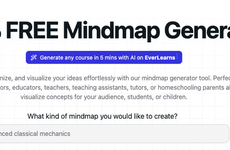
Create aMap Of Your Best Arguments To Impress Friends
Adam Abu-Nab — January 27, 2009 — Tech
References: techcrunch
aMap’s short for “argument map” and is designed to promote the art of arguing by mapping out complex arguments in a simple visual way.
aMaps come both in printed and internet (widget) formats. The printed series of aMaps cover a mixture of weighty and not so weighty arguments including: Does God exist? Cat or dog? Is modern art rubbish? Beatles or Stones? Are children worth it?
The internet version ([url=http://www.amap.org.uk]Amap.org.uk[/url]) allows people to create their own personalised interactive arguments so they can argue with friend (or foe) online.
The initial concept for aMap came from an initial academic research project into the how arguments could be visualised in a simple visual format between us, the new economics foundation and the London School of Economics.
The theory behind aMap is based around “informal logic” - this is the logic people use to argue in everyday life. Informal logic has a four-tiered structure:
- Your position (I think . . .) - what you think overall
- Propositions (Because . . .) - reasons that support your position
- Arguments (As . . .) - supporting arguments that back up each of your propositions
- Evidence (Supported by . . .) - supporting evidence to back up your
aMaps come both in printed and internet (widget) formats. The printed series of aMaps cover a mixture of weighty and not so weighty arguments including: Does God exist? Cat or dog? Is modern art rubbish? Beatles or Stones? Are children worth it?
The internet version ([url=http://www.amap.org.uk]Amap.org.uk[/url]) allows people to create their own personalised interactive arguments so they can argue with friend (or foe) online.
The initial concept for aMap came from an initial academic research project into the how arguments could be visualised in a simple visual format between us, the new economics foundation and the London School of Economics.
The theory behind aMap is based around “informal logic” - this is the logic people use to argue in everyday life. Informal logic has a four-tiered structure:
- Your position (I think . . .) - what you think overall
- Propositions (Because . . .) - reasons that support your position
- Arguments (As . . .) - supporting arguments that back up each of your propositions
- Evidence (Supported by . . .) - supporting evidence to back up your
Trend Themes
1. Visualizing Arguments - Opportunities for software and app developers to create tools for visually mapping out and analyzing complex arguments.
2. Personalized Interactive Arguments - Opportunities for social media and communication platforms to integrate tools for users to create and have interactive arguments.
3. Informal Logic Education - Opportunities for educational institutions and organizations to offer courses and resources to promote the understanding and use of informal logic in everyday life.
Industry Implications
1. Education - The education industry can offer courses and resources on informal logic to promote improved critical thinking and argumentation skills for students and professionals.
2. Software Development - The software development industry can create tools for visualizing and analyzing complex arguments, providing new opportunities for argument mapping software and apps.
3. Social Media - Social media and communication platforms can integrate tools for users to create and have interactive arguments, potentially leading to increased engagement and user retention.
2.3
Score
Popularity
Activity
Freshness























